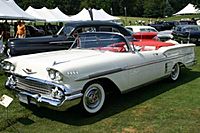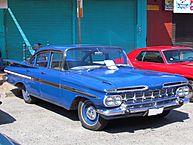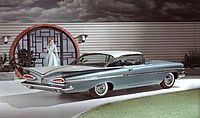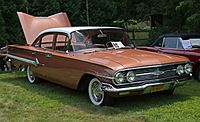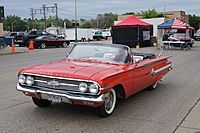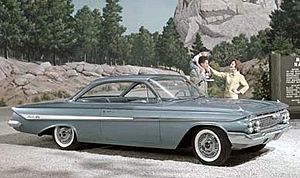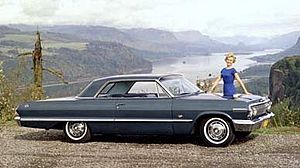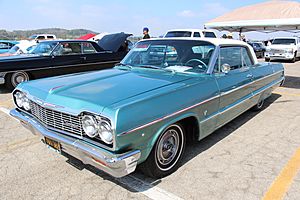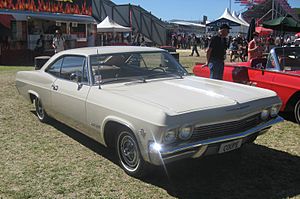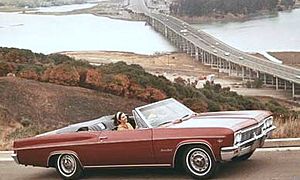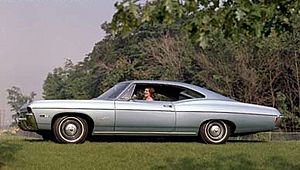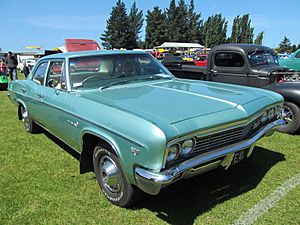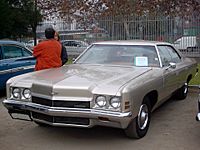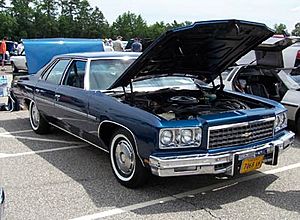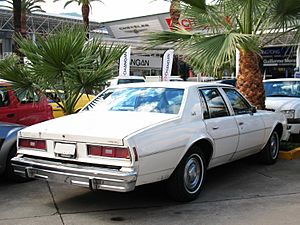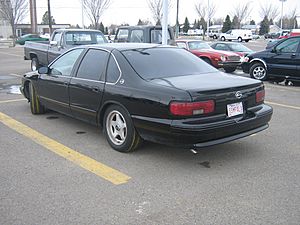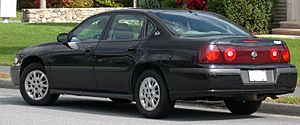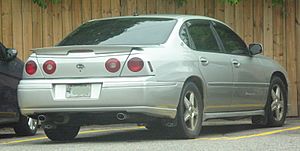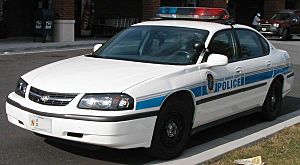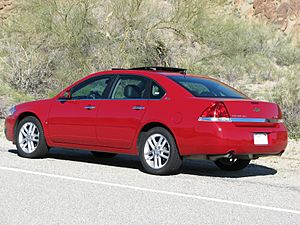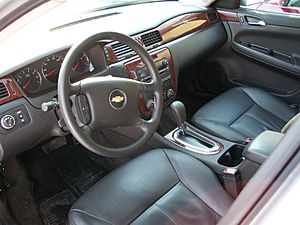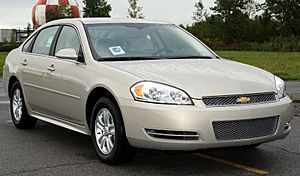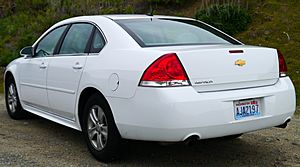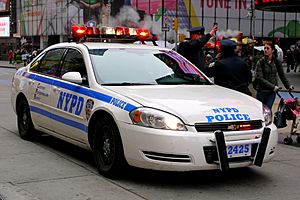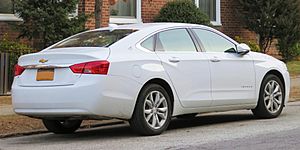Chevrolet Impala facts for kids
Quick facts for kids Chevrolet Impala |
|
|---|---|
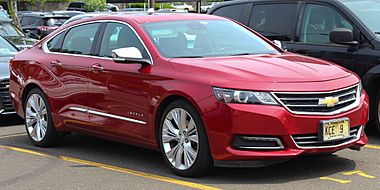
Tenth generation model (2014–2020)
|
|
| Overview | |
| Manufacturer | Chevrolet |
| Production |
|
| Model years |
|
| Body and chassis | |
| Class | Full-size car (Gens 1-7, 10) > Mid-size car (Gens 8-9) |
| Layout | Front-engine, rear-wheel-drive (1958–1996) Front-engine, front-wheel-drive (2000–2020) |
| Chronology | |
| Predecessor | Chevrolet Bel Air Chevrolet Lumina (Gen 2) |
| Successor | Chevrolet SS (for Impala SS) |
The Chevrolet Impala is a full-size car built by Chevrolet for model years 1958 to 1985, 1994 to 1996, and 2000 until 2020. The Impala was Chevrolet's popular flagship passenger car and was among the better selling American-made automobiles in the United States.
For its debut in 1958, the Impala was distinguished from other models by its symmetrical triple taillights. The Chevrolet Caprice was introduced as a top-line Impala Sport Sedan for model year 1965, later becoming a separate series positioned above the Impala in 1966, which, in turn, remained above the Chevrolet Bel Air and the Chevrolet Biscayne. The Impala continued as Chevrolet's most popular full-size model through the mid-1980s. Between 1994 and 1996, the Impala was revised as a 5.7-liter V8–powered version of the Chevrolet Caprice Classic sedan.
In 2000, the Impala was re-introduced again as a mainstream front-wheel drive car. As of February 2014, the 2014 Impala ranked No. 1 among Affordable Large Cars in U.S. News & World Report's rankings. When the tenth generation of the Impala was introduced for the 2014 model year, the ninth generation was rebadged as the Impala Limited and sold only to fleet customers through 2016. During that time both versions were sold in the United States and Canada. The tenth-generation Impala was also sold in the Middle East, and South Korea.
Contents
- History, origin and sales
- First generation (1958)
- Second generation (1959–1960)
- Third generation (1961–1964)
- Impala SS (1961–1969)
- Fourth generation (1965–1970)
- Fifth generation (1971–1976)
- Sixth generation (1977–1985)
- Seventh generation (Impala SS, 1994–1996)
- Eighth generation (2000–2005)
- Ninth generation (2006–2016)
- Tenth generation (2014–2020)
- Discontinuation
- Yearly sales
- Safety
- Awards
- NASCAR
- Images for kids
- See also
History, origin and sales
The Impala name was first used for the full-sized 1956 General Motors Motorama show car that bore Corvette-like design cues, especially the grille. It was named Impala after the graceful African antelope, and this animal became the car's logo. Painted emerald green metallic, with a white interior, the Impala concept car featured hardtop styling. Clare MacKichan's design team, along with designers from Pontiac, started to establish basic packaging and dimensions for their shared 1958 General Motors "A" body in June. The first styling sketch that would directly influence the finished Chevrolet automobile was seen by General Motors Styling vice president Harley Earl in October. Seven months later, the basic design was developed.
First generation (1958)
| First generation | |
|---|---|

1958 Chevrolet Bel Air Impala Sport Coupe
|
|
| Overview | |
| Model years | 1958 |
| Assembly | (main plant) Flint, Michigan, (Flint Assembly (branch assembly) Oshawa, Ontario (Oshawa Car Assembly) Baltimore, Maryland, (Baltimore Assembly) St. Louis, Missouri, (St. Louis Assembly) South Gate, California, (South Gate Assembly) |
| Designer | Joseph R. Schemansky |
| Body and chassis | |
| Body style |
|
| Layout | FR layout |
| Platform | GM B platform |
| Related | 1958 Chevrolet Delray 1958 Chevrolet Biscayne 1958 Chevrolet Bel Air 1958 Chevrolet Yeoman 1958 Chevrolet Brookwood 1958 Chevrolet Nomad |
| Powertrain | |
| Engine | 235 cu in (3.9 L) Blue Flame I6 283 cu in (4.6 L) Turbo Fire V8 348 cu in (5.7 L) W-series Turbo Thrust V8 |
| Transmission | 3-speed manual 3-speed with overdrive manual Turboglide automatic 2-speed Powerglide automatic |
| Dimensions | |
| Wheelbase | 2985 mm (117.5 in) |
| Length | 5310 mm (209.1 in) |
| Width | 1975 mm (77.7 in) |
| Height | 1450 mm (57 in) |
For 1958, GM was promoting their fiftieth year of production, and introduced anniversary models for each brand; Cadillac, Buick, Oldsmobile, Pontiac, and Chevrolet. The 1958 models shared a common appearance on the top models for each brand; Cadillac Eldorado Seville, Buick Limited Riviera, Oldsmobile Starfire 98, Pontiac Bonneville Catalina, and the Chevrolet Bel-Air Impala.
The Impala was introduced for the 1958 model year as top of the line Bel Air hardtops and convertibles. From the windshield pillar rearward, the 1958 Bel Air Impala differed structurally from the lower-priced Chevrolet models. Hardtops had a slightly shorter greenhouse and longer rear deck. The wheelbase of the Impala was longer than the lower priced models, although the overall length was identical. Interiors held a two-spoke steering wheel and color-keyed door panels with brushed aluminum trim. No other series included a convertible.
The 1958 Chevrolet models were longer, lower, and wider than its predecessors. The 1958 model year was the first with dual headlamps. The tailfins of the 1957 were replaced by deeply sculptured rear fenders. Impalas had three taillights each side, while lesser models had two and wagons just one. The Impalas included crossed-flag insignias above the side moldings, as well as bright rocker moldings and dummy rear-fender scoops.
The standard perimeter-type frame was abandoned, replaced by a unit with rails laid out in the form of an elongated "X." Chevrolet claimed that the new frame offered increased torsional rigidity and allowed for a lower placement of the passenger compartment. This was a transitional step between traditional construction and the later fully unitized body/chassis, the body structure was strengthened in the rocker panels and firewall. However, this frame was not as effective in protecting the interior structure in a side impact crash, as a traditional perimeter frame.
A coil spring suspension replaced the previous year's rear leaf springs, and an air ride system was optional.
A 283 cu in (4,640 cc) engine was the standard V8, with ratings that ranged from 185 hp (138 kW) to 230 hp (170 kW). Equipped with optional Rochester Ramjet fuel injection, power output increased to 250 hp (190 kW). Two versions of Chevrolet’s first-ever big-block V8 were optional; the 348 cu in (5,700 cc) in single four-barrel form producing 250 hp (190 kW), or topped with three 2-barrel carburetors, increasing output to 280 hp (210 kW).
A total of 55,989 Impala convertibles and 125,480 coupes were built representing 15 percent of Chevrolet production. The 1958 Chevrolet Bel Air Impala helped Chevrolet regain the number one production spot in this recession year.
Second generation (1959–1960)
| Second generation | |
|---|---|
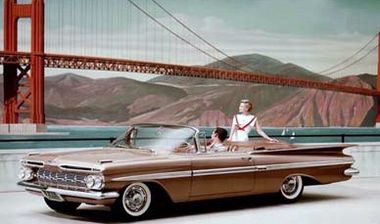
1959 Chevrolet Impala Convertible
|
|
| Overview | |
| Production | 1958–1960 |
| Model years | 1959–1960 |
| Assembly | (main plant) Flint, Michigan, (Flint Assembly (branch assembly) Baltimore, Maryland, (Baltimore Assembly) St. Louis, Missouri, (St. Louis Assembly) South Gate, California, (South Gate Assembly) |
| Designer | Bill Mitchell |
| Body and chassis | |
| Body style |
|
| Layout | FR layout |
| Platform | GM B-body |
| Related | 1959–1960 Chevrolet Biscayne 1959–1960 Chevrolet Bel Air 1959–1960 Chevrolet Brookwood 1959–1960 Chevrolet Parkwood 1959–1960 Chevrolet Kingswood 1959–1960 Chevrolet Nomad 1959–1960 Chevrolet El Camino 1959–1960 Pontiac Catalina |
| Powertrain | |
| Engine | |
| Transmission | 3-speed (close-ratio) manual 3-speed overdrive manual 4-speed manual Turboglide auto. 2-speed Powerglide auto. |
The 1959 Chevrolet Impala was redesigned. Sharing bodyshells with lower-end Buicks and Oldsmobiles as well as with Pontiac, part of a GM economy move, the Chevrolet's wheelbase was 1-1/2 inches longer. Using a new X-frame chassis, the roof line was three inches lower, bodies were two inches wider, and curb weight increased. Its tailfins protruded outward, rather than upward. The taillights were a large "teardrop" design at each side, and two slim-wide nonfunctional front air intake scoops were added just above the grille,
The Impala became a separate series, adding a four-door hardtop and four-door sedan, to the two-door Sport Coupe and convertible. Sport Coupes featured a shortened roof line and wrap-over back window. The standard engine was an I6, while the base V8 was the carryover 283 cu in (4.6 L), at 185 hp (138 kW). Optional were a 283 cu in with 290 hp (220 kW) and 348 cu in (5.7 L) V8 up to 335 hp (250 kW). Standard were front and rear armrests, an electric clock, dual sliding sun visors, and crank-operated front vent windows. A contoured hooded instrument panel held deep-set gauges. A six-way power seat was a new option, as was "Speedminder", for the driver to set a needle at a specific speed and a buzzer would sound if the pre-set was exceeded.
The 1960 Impala models reinstated three round taillights on each side, and a white band running along the rear fenders.
The available V8s were reduced to seven, in 283-cu in or 348-cu in displacements. The carbureted Turbo-Fire 283 cu in V8 could have either 170 or 230 hp (130 or 170 kW). The 348 cu in was available in 250 to 320 hp (190 to 240 kW) with a 350 hp (260 kW) Special Super Turbo-Thrust with triple two-barrel carburetors, 11.25:1 compression ratio, and dual exhausts. Fuel injection was no longer an option on full-size Chevrolets. New to the options list was speed and cruise control.
Production was 490,000 units.
Exports
Right-hand drive cars were made in Oshawa, Ontario, Canada, for New Zealand, Australia, and South Africa and assembled locally from CKD or SKD kits. The right-hand drive dashboard was a mirror image of the 1959 Chevrolet panel and shared with equivalent right-hand drive Pontiac models. Australian models were assembled by hand on the GMH Holden assembly lines. The Australian Impala was the first American post-war import to come standard with a V8 engine.
Third generation (1961–1964)
| Third generation | |
|---|---|

1961 Chevrolet Impala Convertible
|
|
| Overview | |
| Production | 1960–1964 |
| Model years | 1961–1964 |
| Assembly | United States: (main plant) Flint, Michigan, (Flint Assembly (branch assembly) Arlington, Texas, (Arlington Assembly) St. Louis, Missouri, (St. Louis Assembly) South Gate, California, (South Gate Assembly) Baltimore, Maryland, (Baltimore Assembly) India: Calcutta New Zealand: South Africa: |
| Body and chassis | |
| Body style |
|
| Layout | FR layout |
| Platform | B-body |
| Related |
|
| Powertrain | |
| Engine |
|
| Transmission | 3-speed Automatic 4-speed Manual Powerglide |
| Dimensions | |
| Wheelbase | 3025 mm (119 in) |
| Length | 5315 mm (209.3 in) |
1961
The Impala was restyled on the GM B platform for the first time for 1961. The new body styling was more trim and boxy than the 1958–1960 models. Sport Coupe models featured a "bubbleback" roof line style for 1961, and a unique model, the 2-door pillared sedan, was available for 1961 only. It was rarely ordered. A "Super Sport" (SS) option debuted for 1961. This was also the last year the top station wagon model would have the Nomad name. Power brakes were $43.
1962
The 1962 model featured new "C" pillar styling for all models except the 4-door hardtop. Sport Coupe models now featured the "convertible roof" styling, shared with other GM "B" full-size hardtop coupes, although the less expensive Bel Air hardtop was still available with the 1961-style roofline. This style proved popular. The "overhang" roof style of the sedans was replaced with a wider "C" pillar with wraparound rear window. These engines could only be ordered with a manual shift transmission. The small-block 283 was offered with a two barrel carburetor. The 283 was also enlarged to 327-cubic-inch (5.4 L), offered in two versions, one with 250 bhp (186 kW) and one with 300 bhp (224 kW), which added more engine choices for small-block fans. The Beach Boys produced a hit single, "409", referring to the Chevrolet, which became an iconic song for these cars. Impalas again featured premium interior appointments, plusher seats could be done by the dealerships on customer request. And more chrome trim outside, including a full-width aluminum-and-chrome panel to house the triple-unit taillight assembly. Super Sport (SS) models featured that panel in a special engine-turned aluminum, which was also used to fill the side moldings, making the SS more distinctive in appearance. The Impala also gained the top trim station wagon body design, in place of the Chevrolet Nomad model. However, unlike the passenger cars, Impala wagons had dual-unit taillights. Due to reliability problems, the optional Turboglide automatic transmission was discontinued, leaving Powerglide the only automatic transmission available until 1965. A new radio was optional.
1963
The 1963 Impala featured rectilinear styling with an engine-turned aluminum rear taillight panel surrounded by a chrome border on SS models. Engine choice was similar to 1962, with the small-block 283 cu in (4.6 L) and 327 cu in (5.4 L) V8s most popular. The Sport Sedan featured a new, creased roof line. A new "coved" instrument panel included simple indicator lights for hot and cold engine conditions. An optional factory tachometer was built into the dashboard, just above the steering wheel. Impala wagons got triple-unit taillights for the first time.
A special 427 cu in (7.0 L) version of the 409 cu in (6.7 L) engine was used in the 1963 Chevrolet Impala Sport Coupe, ordered under Chevrolet Regular Production Option (RPO) Z11. This was a special package created for drag racers and NASCAR and included a 427 with aluminum body parts and a cowl-induction air intake system. The aluminum body parts were fabricated in Flint, Michigan at the facility now known as GM Flint Metal Center. Unlike the later second-generation 427, it was based on the W-series 409 engine, but with a longer 3.65 in (93 mm) stroke. A high-rise, two-piece aluminum intake manifold and dual Carter AFB carburetors fed a 13.5:1 compression ratio to produce 430 horsepower (320 kW) and 575 lb⋅ft (780 N⋅m) of torque. Fifty RPO Z11 cars were produced at the Flint GM plant.
1964
For 1964, the Impala was restyled to a more rounded, softer look. The signature taillight assembly had an "upside-down U" shaped aluminum trim strip above the taillights, but the individual lights were surrounded by a body-colored panel. The 409 cu in (6.7 L) V8 engine returned as the big-block option, as well as the Rochester 2X4-barrel carburetors setup for the 425 bhp (431 PS; 317 kW) at 6,000 rpm and 425 lb⋅ft (576 N⋅m) at 4,200 rpm of torque engines. SS models continued to feature the engine-turned aluminum trim. Rooflines were carried over from 1963 unchanged. Back-up lights were standard.
All full size 1964 Chevrolet station wagons got small rectangular taillight lenses mounted vertically, one for each side of the car.
The 1964 model year is a staple of lowrider culture, and it is commonly mentioned in West Coast hip hop lyrics.
Exports
Right hand drive cars were made at GM's Oshawa plant in Canada and often shipped overseas in kit form for assembly in South Africa, New Zealand and Australia. The RHD cars — Chevrolet or equivalent Pontiac (built on Chevrolet frames and using Chevrolet engines in Canada) — all used a right hand drive version of the left hand drive 1961 Pontiac dashboard.
Impala SS (1961–1969)
In a December 17, 1960 press release Chevrolet Motor Division introduced the Impala SS (Super Sport) option to the market. The SS badge was to become Chevrolet's signature of performance on many models, though it often has been an appearance package only. The Impala's factory SS package in 1961 was truly a performance package when so equipped from the factory with both the trim and "mandatory" suspension and engine upgrades, beginning with the 348 cu in (5.7 L) V8 engines available with 305 hp (227 kW; 309 PS), 340 hp (254 kW; 345 PS), and 350 hp (261 kW; 355 PS) or the new 409 cu in (6.7 L) V8, which in 1961 was rated at 360 hp (268 kW; 365 PS). Unlike all other years, the 1961 Super Sport package was available on any Impala, including sedans and station wagons (the sales brochure shows a 4-door hardtop Sport Sedan with the SS package). The package also included upgraded tires on station wagon wheels, springs, shocks and special sintered metallic brake linings. Only 142 1961 Impala Super Sports came from the factory with the 409. In addition to the factory-installed SS package, Chevrolet dealers could add SS trim to any standard Impala without the "mandatory" performance upgrades, and a number of '61s were so equipped.
Starting for the 1962 model year, the Impala SS was an appearance package limited to hardtop coupe and convertible coupe models, available with all engines in the Impala series starting with the base 235 cu in (3.9 L), 135 hp (101 kW; 137 PS) inline-6 through 1967, though the big-block engines and heavy-duty parts could still be ordered. From 1967 to 1969, an additional model, the SS427, was available.
The Super Sport was known as Regular Production Option (RPO) Z03, from 1962 to 1963, and again in 1968. From 1964 through 1967, the Super Sport was a separate model, with its own VIN prefix (for example in 1965-67 cars, 164 was the prefix for a regular Impala with a V8 engine, 166 or 168 were used in 1966-68 for a V8-equipped Impala SS). Super Sports from 1962 to 1964 came with engine-turned aluminum trim, which was replaced by a "blackout" trim strip in 1965 which ran under the taillights.
Fourth generation (1965–1970)
| Fourth generation | |
|---|---|

1965 Chevrolet Impala Sport Coupe
|
|
| Overview | |
| Production | 1964–1970 |
Redesigned in 1965, the Impala set an all-time industry annual sales record of more than 1 million units in the United States. All new full-size Chevrolets eschewed the "X" frame for a full-width perimeter frame, a new body that featured curved, frameless side glass (for pillarless models), sharper angled windshield with newly reshaped vent windows, and redesigned full-coil suspension.
In 1965, Chevrolet introduced a new luxury package for the Impala four-door hardtop, called "Caprice" and coded as RPO Z18. Caprices received tufted upholstery, wood grained accents on the dashboard and specialty pulls on the insides of the doors. This "halo" model also featured the "spinner" wheel covers from the Impala SS, with the "SS" logo centers replaced by a Chevrolet "bowtie" emblem. The Super Sport's blackout rear trim strip below the triple taillights was also used, with the "Impala SS" emblem replaced by a large "Caprice by Chevrolet" badge. The Impala block lettering on each front fender was replaced with "Caprice" script. The Caprice package was reintroduced as the Chevrolet Caprice Custom in 1966, taking the top position in the full-size Chevrolet lineup.
Engine choices included the inline six-cylinder as well as the small-block and big-block V8s. A new three-range Turbo Hydra-Matic automatic transmission was optional for 396 cu in (6.5 L) V8. The old 409 cu in (6.7 L) "W" engine was discontinued early in the 1965 model year, so early-production 1965s got the 409, as well as 1/10 of 1% had the 396 CID big-block. Other later-built cars had the 396 cu in (6.5 L) as the big-block option. Two-speed Powerglide, as well as 3- and 4-speed manual transmissions were available. As with previous years, Impalas featured more chrome trim inside and out, with pleated tufted upholstery and door panels. The Impala would be the #2-selling convertible in the US in 1966, with 38,000 sold; it was beaten by the Mustang by almost 2:1. 1966 saw a pair of enlarged big-block V8s featuring 427 cu in (7.0 L). The RPO L36 was rated at 385 hp (287 kW), the L72 at 425 hp (317 kW). The L72 was only available with a manual transmission.
The 1967 model was redesigned with enhanced Coke bottle styling that featured Corvette-inspired front and rear fender bulges. The curves were the most pronounced with the 1967–1968 models. In keeping with federal regulations, safety features were built into Impalas during the 1967 and 1968 model years, including a fully collapsible energy-absorbing steering column, side marker lights, and shoulder belts for closed models. The L72 engine was not available in 1967, but a L36 Turbo-Jet V8 was optional.
The 1968 model was facelifted with a new front end. The new rear bumper housed triple "horseshoe" shaped taillights. 1968 also saw a new Impala model, the Custom Coupe. This two-door hardtop featured the same formal roofline as the Caprice Coupe. It was successful and would be continued through 1976. The L72 "427 Turbo-Jet" engine was once again returned to the option list, a solid-lifter V8 rated at 425 hp (317 kW). It would continue to be available for both 1968 and 1969, replaced by the Turbo-Jet 454 for 1970.
The 1969 Impala and other full-sized Chevrolets got new slab-sided bodies with a small "upsweep" at the rear quarter window, giving them a more formal appearance. It retained the 119-inch wheelbase from previous models. New front bumpers that wrapped around the grille and horizontal taillights were in the rear bumper. The hardtop Sport Coupe got a new notchback roofline, replacing the "fastback" C-pillar from 1967 to 1968. Ventless front windows were used on all models. Chevrolet had a rudimentary "power vent" system featuring vents in the instrument panel. The ignition switch was moved from the instrument panel to the steering column, and when the key was removed, the steering wheel and shift lever were locked.
The 1969 model year Impala production topped Caprice production by 611,000 units. Impala station wagons were renamed Kingswood, a name which would continue through 1972. The similar 1970 Impala got a minor facelift featuring a more conventional under the grille bumper replacing the wrap-around unit used in 1969 along with new triple vertical taillights in the rear bumper. Canadian buyers got the choice of a lower priced companion to the Impala Sport Coupe, the Bel Air Sport Coupe, which used the same body but featured Bel Air trim.
Exports
Right hand drive cars were manufactured in Canada for export to countries such as Australia, New Zealand, South Africa, the United Kingdom, etc., until 1969. They used a version of the 1965 Impala dash panel — without provision for a radio and installed in a dashboard moulding made of fibreglass, not metal — until 1969. Radios (centrally mounted) and heaters were locally sourced and wipers parked in the center of the windscreen.
Australian models were assembled in Australia by General Motors-Holden from kits, as this lessened tax on the cars. The Australian cars had locally sourced amber flashing rear indicators replacing the clear reversing lenses, as red indicators were illegal.
New Zealand models were assembled by General Motors New Zealand with bodies supplied from Canada already welded, painted and trimmed.
Fifth generation (1971–1976)
| Fifth generation | |
|---|---|
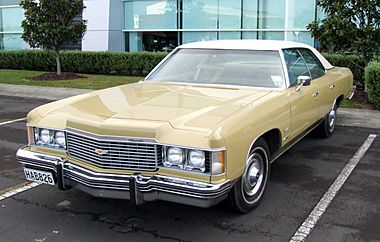
1974 Impala Sport Sedan
|
|
| Overview | |
| Production | 1970–1976 |
The Impala remained Chevrolet's top-selling model with the fifth generation. A high-performance big block V8 was still available in the form of the Turbo-Jet 454, which produced 365 hp (272 kW) in 1971, but power decreased as the years went along. The 1971 redesigned B-body would be the largest car ever offered by Chevrolet. The hardtop Sport Coupe continued to be offered; it was a smoothly sloped semi-fastback reminiscent of the 1961 "bubbletop" styling. A three-speed manual transmission remained standard at the beginning of the year, but in the spring of 1971 all V8-equipped full-size GM cars got Turbo Hydra-Matic as standard equipment. Powerglide remained optionally available for six-cylinder cars until the 1973 models. In keeping with their huge size, these new "B" body Chevrolets were close to Cadillac in luxury features, styling, and ride. Like all GM "B" bodied cars, Impala got a new power ventilation system that remained on while the ignition was on, and included both large vents in the instrument panel and louvers in the trunk. However, the system proved to be problematic and was disliked by many buyers. Power assisted front disc brakes were standard for all models for 1971; variable-ratio power steering became standard in 1972
The 1972 model has a grille which extended below the bumper. Powertrains consisted of mostly V8 engines. The 250 inline six was still standard for Sport Coupe and 4-door sedan models; the 350 2bbl V8 became the standard engine from 1973–1976, with 350 cubic inches (5.7 L), 400 cubic inches (6.6 L), 402 cubic inches (6.6 L) (through 72) or 454 cubic inches (7.4 L) optional. The best-selling body style was the formal-roof Custom Coupe. Beginning in 1972, all engines were designed to run on unleaded gasoline. 1972 saw the last Impala convertible; it sold 6,456 units, placing fourth with just under 9 percent of the market, right behind the Corvette's 6,508 units sold, ahead of the Mustang's 6,401 units sold. The power ventilation system was improved, and exit vents were moved from the trunk lid to the door pillars.
All 1973 Chevrolet vehicles featured a larger, shock-absorbing front bumper due to new federal mandates which required 5-mile-per-hour (8.0 km/h) impact protection. New taillights were mounted in the (still) conventional rear bumper. The convertible was moved upmarket to the Caprice Classic series. Tweaks to the suspension and frame gave better roadability, according to Chevrolet general manager John Z. DeLorean. Steering wheels and instrument panels were color-keyed to interior colors, as opposed to the matte black used in 1971–1972. The steering wheel rim got a soft-feel grip, and replaced the "Impala" badge with generic "Chevrolet." The inline six-cylinder engine was now offered on the Bel Air 4-door sedan only, and only with the 3-speed manual transmission. Interiors had repositioned front seats for more legroom. The Impala name returned for the Kingswood station wagon. Suspension and chassis design was modified for better roadability. The bench front seat position was modified to fit tall drivers more comfortably; shorter drivers found it less so.
One thousand 1973 Impalas were built with an "Air Cushion Restraint System" (ACRS) that used an Oldmobile instrument panel and unique steering wheel that contained both a driver and front passenger air bag. They were all four-door sedans painted in a special green-gold color. The system was not advertised in a big way and many of the cars were used for crash testing by both GM and the Federal government. Over the decades the system proved durable and successfully protected front passengers in front-end collisions. Unfortunately Chevy did not offer ACRS in 1974; however it was offered in Oldsmobile, Buick, and Cadillac models that year as an option and did save lives. One ACRS-equipped Impala was preserved and remains a witness to the ability of an American automaker to design life saving safety systems into cars without a government mandate. No other examples are known as of this time.
In 1974, the rear bumper was redesigned with shock absorbers to meet the upgraded standards and new tail lights were added. The front end was also freshened as in previous years, with a new grille and headlight bezels, a new header panel, and a bumper with a drop down center section. The marker lights moved back up beside the headlamps once again. This was the only year of the 1971–1976 models the Impala had a different front end design than the Caprice Classic, as other years used either a grille insert or previous year Caprice front to distinguish the two. The rooflines of the Impala coupes were also revised. For 1974 the Custom Coupe was no longer a hardtop, with large fixed rear quarter glass and a thick B-pillar. The Sport Coupe, still a pillar-less hardtop, now used larger roll-down quarter glass like that of the 1971–1973 Custom Coupe, and had a narrower, fastback style, flat back window. Sedans used carryover body shells from previous years. In an unusual styling move, the optional Impala wheel covers for 1974 were the same as the 1970 Impalas.
A limited-edition Spirit of America package was offered in 1974 on Sport Coupe models; primarily an appearance package, it featured white or blue body paint, a white full vinyl top, white upholstery with red or blue trim, color-keyed seat belts and floormats, special wheel covers, optional white rally wheels, sports-styled dual remote outside rear view mirrors, a vinyl body side molding insert, and red pin-striping. Special fender and dashboard badges announced the package to passers-by and passengers. Chevrolet also offered Nova and Vega Spirit of America versions as well.
The 1975 Impala used a 1974 carried-over Caprice front end, with a grille insert and emblem change. The Caprice model was revised with a new front end with a swept back style header panel with recessed headlight buckets, a new hood, and new fenders. Also in 1975 upholstery, door panels and the dashboard were revised as were the radio and climate control graphics. Speedometers read up to 100 mph (160 km/h), and added kilometers per hour. A High Energy Ignition (HEI) system was officially introduced in 1975, although it was installed on some 1974 cars as a clandestine option. Catalytic converters were also introduced, as were several new options, including an Econominder gauge package (which also included a coolant temperature gauge), intermittent wipers, and a divided 50/50 bench seat with passenger-side recliner (with a choice of sport cloth or vinyl trim). This was the final year of the full-size Chevrolet convertible. Four-door models got new rooflines; the hardtop Sport Sedan got a small triangular "opera window" carved out of the wide roof panel.
A Landau model available for 1975–1976 models featured a landau vinyl roof (with a chrome band across the roof), a choice of special paint colors, sports-styled dual remote outside rearview mirrors, color-keyed wheel covers, a vinyl bodyside molding insert, and pin-striping. Inside were color-keyed seat belts and floormats. Fender and dashboard emblems rounded out the package. The 2-door hardtop model (dubbed the "Sport Coupe") was discontinued after 1975, leaving redesigned Custom Coupe, with its wide "B" pillar and fixed rear window, the only 2-door Impala available in 1976. This body style had been introduced for the 1974 model year, a precursor to Detroit's complete abandonment of pillarless body styles before the end of the Seventies. 1976 Impalas used a previous year Caprice nose, with a new "egg crate" grille insert. The Impala had round headlamps while the Caprice used the new quad rectangular ones. For fleet buyers, Chevrolet offered a lower priced Impala "S" model that deleted some of the standard model's luxury features, such as radial tires, sound insulation and trunk light. The "S" was available in both a 4-door sedan and station wagon, and effectively replaced the Bel Air for the U.S. market (the Bel Air continued in production in Canada until 1981).
Sixth generation (1977–1985)
| Sixth generation | |
|---|---|
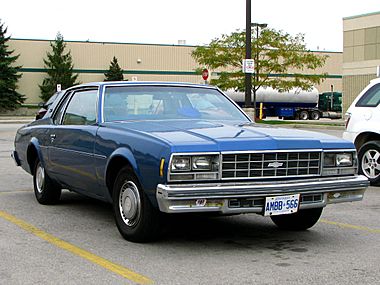
1977 Chevrolet Impala Coupe
|
|
| Overview | |
| Production | 1976–1985 |
| Model years | 1977–1985 |
| Assembly |
|
| Body and chassis | |
| Body style |
|
| Layout | FR layout |
| Platform | B-body |
| Related |
|
| Powertrain | |
| Engine | |
| Transmission |
|
| Dimensions | |
| Wheelbase | 116 in (2,946 mm) |
| Length | 212.1 in (5,387 mm) |
| Width | 75.5 in (1,918 mm) |
| Height | 55.3 in (1,405 mm) |
The changes in the automobile marketplace resulted in Chevrolet redesigning the Impala once again in 1976 to meet changing demands. The new downsized Impalas were shorter in length, taller and narrower than before. The new Impala's frame was a shortened version of the one introduced in 1970 and would be utilized until 1996 when the B-body production line was shut down. Even with its trimmer exterior dimensions, the new Impala featured increased headroom, rear-seat legroom and trunk space. Production of the downsized model increased substantially over 1976, and the Impala regained the number one US sales position. The redesigned 1977 Impala/Caprice was named Motor Trend's car of the year. The new body was taller and narrower than the 1976 model.
Pillarless hardtops were discontinued, the result of rumors of federal rollover standards looming in the near future. The 1977–1979 coupes sported a double bent tempered rear window similar to the 1987 Chevrolet Monte Carlo Aerocoupe. In 1980, all new sheet-metal was used, although the body style remained similar.
Engine availability was reduced for 1977; the inline-6 was reintroduced with 110 hp (82 kW). Options included 267-and-305-cubic-inch (4.4 and 5.0 L) V8 engines. The 350-cubic-inch (5.7 L) V8 engine was optional in some years. Oldsmobile's 350-cubic-inch (5.7 L) V8 diesel engine also was available. Starting in 1980, the inline 6 was replaced by a generic 229 cubic-inch V6 from Chevrolet which was totally different from the 3.8 liter (231 cubic inch) V6 from Buick that was installed in numerous GM models of different divisions.
The Impala and the upscale Caprice sold well into the early 1980s. The Impala was reduced to the base model full-size Chevrolet and was popular with fleet usage – including taxi and police-pursuit vehicles, but had coupe and wagon body styles dropped after 1981 and was discontinued in 1985, while the Caprice continued unchanged until 1990. Upon the demise of the Impala, the base model full-size Chevrolet was rebranded Caprice starting in 1986, with the upper models being called the Caprice Classic and Caprice Classic Brougham.
In some model years these vehicles were also assembled in Southgate, CA and St. Louis, MO (which also assembled the Corvette through part of the 1981 model year).
Seventh generation (Impala SS, 1994–1996)
| Seventh generation | |
|---|---|
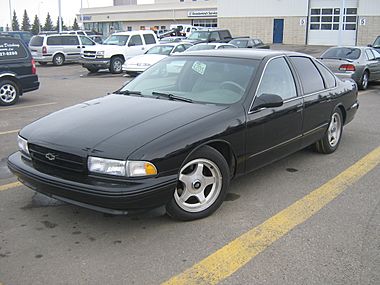
Chevrolet Impala SS 4-door sedan
|
|
| Overview | |
| Also called | Chevrolet Caprice SS (Middle East) |
| Production | February 14, 1994 – December 13, 1996 69,768 total units produced |
| Model years | 1994–1996 |
| Assembly | United States: Arlington, Texas, (Arlington Assembly) |
| Body and chassis | |
| Body style | 4-door sedan |
| Layout | FR layout |
| Platform | B-body |
| Related |
|
| Powertrain | |
| Engine | 5.7 L (350 cu in) LT1 V8 |
| Transmission | 4-speed 4L60-E automatic |
| Dimensions | |
| Wheelbase | 115.9 in (2,944 mm) |
| Length | 214.1 in (5,438 mm) |
| Width | 77 in (1,956 mm) |
| Height | 54.7 in (1,389 mm) |
| Weight | 4,036 lb (1,831 kg) |
In January 1990, the GM B platform's body was redesigned for the 1991 model year, though it retained the same shortened frame design of the 1977 model year redesign. The Impala SS badge was resurrected at the 1992 Detroit Auto Show as a concept car designed by GM designer Jon Moss. The concept car was two inches lower to the ground than the regular Caprice, and was powered by an 8.2-liter (500 cu in) engine. Eventually, the concept car's engine was replaced with a 5.7-liter (350 cu in) LT1 V8 engine derived from the Corvette.
The 1994 Impala SS went into production on February 14, 1994, at GM's plant in Arlington, Texas, and was almost identical cosmetically to the concept car, the only noticeable change being the chromed bowtie logo on the grill (vs. a red logo on the concept). The car was, in essence, a high-performance version of the Caprice heavily based on the Caprice 9C1 police package. As such, it got much of the equipment formerly available only to law enforcement and government agencies. This included a sport-tuned suspension with reinforced shocks and springs, a high-capacity reverse-flow cooling system (derived from the Corvette's LT1), four-wheel disc brakes, transmission cooler, dual exhaust, a higher-output electrical system, and other minor mechanical and electrical alterations.
The Impala SS was fitted with a standard 3.08 gear. The limited-slip rear differential was standard (as opposed to the optional G80 on Caprices) and the suspension was an inch lower. A retuned LT1 5.7-liter (350 cu in) small-block V8 was standard on the Impala SS, making 260 hp (194 kW; 264 PS) and 330 lb⋅ft (447 N⋅m) of torque (retuned from the prototype's 300 hp (224 kW; 304 PS) rating). The primary difference between the LT1 in the Impala and the LT1 that was in the Corvette and Camaro was that the Impala engine was fitted with cast-iron cylinder heads instead of aluminum ones, and a camshaft that was designed more for low-end torque than high-end horsepower. Another difference was that the block casting for the Impala LT1 had two-bolt main bearing caps while the casting used for the Corvette LT1 had four-bolt main bearing caps. The transmission was the 4L60E, which was an electronically controlled version of the previously hydraulically controlled 4L60. However, the transmission was not beefed up for the power of the LT1, nor the extra weight of the body and frame, and transmission failures after 100,000 miles (160,000 km) were commonplace.
The Impala SS received body-colored trim, a unique single-bar grille with no hood ornament, and a rear deck spoiler. It was fitted with 17-inch (430 mm) brushed aluminum wheels with 255/50ZR17 all-season tires. Inside, the car came with a central console with cup holders (1994 and 1995 models) and a storage compartment, leather seats embroidered with the Impala SS logo, and a standard leather-wrapped steering wheel. For the 1994 model year, it was available only in black with a gray interior. Due to a shortage of the unique five-spoke aluminum wheels, only 6,303 cars were sold. However, the wheel shortage was remedied for the 1995 model year and 21,434 cars were sold.
In 1995, Dark Cherry Metallic and Dark Grey Green were added as exterior color options, and the body paneling on the rear quarter panel was altered to reflect the cosmetic effect formerly achieved by a window insert. The black units continued to receive semi-gloss door moldings and wheel-well trim whereas the other color offerings received those items in full gloss. Another change from 1994 was the placement of the side mirrors from pods attached to the door to a larger format attached to the 'A' pillar. 1996 was the last year of production with 41,941 units sold. The 1996 Impala SS was also exported to the Middle East, as the Caprice SS, with the car being identical to its American counterpart except for the side fonts on the rear quarter panel and the badge on the dashboard saying Caprice SS. The 1996 Impala SS production went late into the model year; the last one being produced on December 13, 1996. Marblehead Gray Metallic had been planned for that final year however the option was cancelled at the last minute even though many trim part numbers for the color had already been designated. The last year saw minor interior alterations, with the digital speedometer being replaced by an analog one, along with a tachometer. The shifter was moved from the column to the center console, and the engine was given an OBD-II computer control system (the camshaft was reground to adjust for the new computer).
Performance
260hp 350 (base version)
- 0–60 mph (0–97 km/h): 7.0 seconds
- 1⁄4 mi (400 m): 15.3 seconds at 91.1 mph (146.6 km/h)
- Top speed: 142 mph (229 km/h)
404hp 383 (Callaway Supernatural SS)
Source:
- 0–60 mph (0–97 km/h): 5.9 seconds
- 1⁄4 mi (400 m): 14.0 seconds at 100.3 mph (161.4 km/h)
- Top speed: N/A
Discontinuation
The entire B-body line, consisting of the Chevrolet Caprice, Impala SS, and Buick Roadmaster, was discontinued, as GM wanted more assembly lines to be able to produce more profitable SUVs. A ceremony was held at the plant on December 13, 1996, as the last Impala SS was produced.
Eighth generation (2000–2005)
| Eighth generation | |
|---|---|
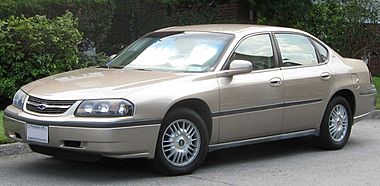
Chevrolet Impala Sedan
|
|
| Overview | |
| Production | 1999–2005 |
| Model years | 2000–2005 |
| Assembly | Canada: Oshawa, Ontario (Oshawa Car Assembly) |
| Designer | John Cafaro |
| Body and chassis | |
| Body style | 4-door sedan |
| Layout | Transverse front-engine, front-wheel drive |
| Platform | W-body 2nd Gen |
| Related |
|
| Powertrain | |
| Engine | |
| Transmission |
|
| Dimensions | |
| Wheelbase | 110.5 in (2,807 mm) |
| Length | 200.0 in (5,080 mm) |
| Width | 73 in (1,854 mm) |
| Height |
|
| Weight | 3,465 lb (1,572 kg) |
The Impala name was revived for the 2000 model year. With a wheelbase three inches longer (though an inch shorter overall) than the Mid-size Lumina, the new Chevy Impala was categorized as full-size by cars.com but mid-size by Consumer Guide Automotive. Based on the Lumina's W-body platform, it was built at Oshawa Car Assembly in Oshawa, Ontario, Canada. Unlike the earlier Impalas built on a B-body, this one was front-wheel drive and was available with a choice of two engines, the ever-enduring 3.8L V6 engine, and the slightly smaller 3.4L V6 engine. A new Impala SS with a supercharged V6 was brought out for the 2004 model year.
The Impala was available in two trim levels from 2000 to 2003. The base model came equipped with cloth bench seats, steel wheels, the 180 horsepower (134 kW) 3.4 liter (204 cu in) LA1 V6, and a 3-gauge instrument cluster. The LS came factory-equipped with cloth bucket seats upgradeable to leather with center console and floor shift, color-keyed "Impala" door scripts and trunk badge, anti-lock brakes, traction control system, keyless remote entry, integrated foglamps, aluminum wheels upgradeable to alloy wheels, rear spoiler (optional on the base models), 4-gauge instrument cluster (with tachometer), and the larger 200 horsepower (149 kW) 3.8 liter (231 cu in) L36 V6. Options available on all models included a sunroof, OnStar system, Driver Information Center with built-in HomeLink system, heated power front seats, and 16 inch 1990s SS-inspired wheels. All models came equipped with power windows, door locks, and mirrors. The rear spoiler was an option on base models, and could be deleted from LS models upon buyers request.
The 2004 to 2005 Impala SS came equipped with the 3.8 liter (231 cu in) supercharged L67 V6 engine. It was rated at 240 horsepower (180 kW) and had been previously used in the Pontiac Grand Prix GTP, Buick Regal GS, Buick Riviera, and H-body Pontiac Bonneville SSEI and Buick Park Avenue "Ultra". The lighter front-wheel-drive sedan was as quick as the vaunted 1990s Impala SS, with 0–60-mile-per-hour (0–97 km/h) times pushing 6.5 seconds, compared to the earlier model's time also showing 6.5 seconds (albeit 7.1 seconds on average). To commemorate Chevrolet's long relationship with the Indianapolis Motor Speedway and the Indianapolis 500 race, a limited edition (4,088 produced) Impala Indy SS was offered in 2004, featuring black grille with gold Chevrolet bowtie emblem that would be carried over to all Impala models in 2005, various Indy logos on the exterior and interior, 17-inch chrome wheels, gauge cluster package, and more.
Impala 9C1 and 9C3
Also released with this version were the 9C1 Police Package, first released in 2000, as well as the 9C3 Undercover Police Package first released in 2001. Available only to law enforcement agencies, fire departments, and EMS agencies, it has had much more success than its predecessor, the Lumina 9C3. The 9C1 was a base model with a stronger suspension and the 3.8 liter (231 cu in) V6 engine. It also came with the option for a rear vinyl bench seat and front cloth bucket or bench seats, both cloth front and rear seats, or vinyl front and rear seats. It also offered preparation for a criminal cage to be installed between the front and rear seats. It was only available in a few basic colors. Another addition was the "SURV MODE" switch that replaced the fog light switch found on the LS. This enabled the driver to turn off all lights in the vehicle and "hide"; something not allowed with the civilian models, as automatic headlights were standard. The 9C3 was comparably equipped to the 9C1, but the ability to add other convenience options and more paint and interior choices set the 9C3 apart.
Sales for the Impala 9C1 and 9C3 were strong with law enforcement and they were especially popular with large city fleets such as the NYPD and Philadelphia Police Department. However, the Ford Crown Victoria P71 still held the sales lead and was preferred by most agencies due to its larger size, much more durable V8 engine, rear wheel drive layout, and body-on-frame platform.
Engines
| Engine | Power | Torque |
|---|---|---|
| 3.4L (204 CID) LA1 V6 | 180 hp (134 kW) @ 5200 rpm | 205 lb⋅ft (278 N⋅m) @ 4000 rpm |
| 3.8L (231 CID) L36 V6 | 200 hp (149 kW) @ 5200 rpm | 225 lb⋅ft (305 N⋅m) @ 4000 rpm |
| 3.8L (231 CID) L67 Supercharged V6 | 240 hp (179 kW) @ 5200 rpm | 280 lb⋅ft (380 N⋅m) @ 4000 rpm |
Ninth generation (2006–2016)
| Ninth generation | |
|---|---|
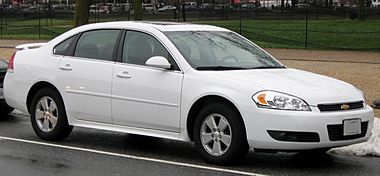 |
|
| Overview | |
| Production | 2005–2013 2014–2016 (as Impala Limited) |
| Model years | 2006–2013 2014–2016 (as Impala Limited) |
| Assembly | Oshawa, Canada (Oshawa Car Assembly) |
| Designer | Louis "Chip" Thole |
| Body and chassis | |
| Body style | 4-door sedan |
| Layout | Transverse front-engine, front-wheel drive |
| Platform | W-body 3rd Gen |
| Related |
|
| Powertrain | |
| Engine | |
| Transmission |
|
| Dimensions | |
| Wheelbase | 110.5 in (2,807 mm) |
| Length | 200.4 inches (5,090 mm) |
| Width | 72.9 inches (1,850 mm) |
| Height | 58.7 in (1,491 mm) |
| Weight | 3,764 lb (1,707 kg) |
2006
The 2006 Impala was introduced at the 2005 Los Angeles Auto Show in January. Like the Buick LaCrosse, the ninth generation Impala used the updated GM W platform. The base engine was a 3.5 L (214 cu in) V6 producing 211 hp (157 kW) and 214 lb⋅ft (290 N⋅m) of torque at 4,000 rpm. The new Impala featured new taillights, different from the four-circle style of the previous generation. This Impala mostly sold to fleet operators, with private buyers accounting for a quarter of sales.
The SS model used the Generation IV small-block V8, the first to do so in a front-wheel-drive Chevrolet, and the first V8 in a Chevrolet sedan since the 1996 Caprice. The 5.3 L (325 cu in) V8 (with Displacement on Demand, called Active Fuel Management or AFM) produced 303 hp (226 kW). With the use of the 5.3 L LS4 V8, the Impala SS is capable of a 5.6 second 0–60 mph (0–97 km/h) time and a quarter-mile time of 14.2 seconds traveling at 101 mph (163 km/h). The ninth generation Impala was 200.4 in (5,090 mm) long, 58.7 in (1,491 mm) high, and 72.9 in (1,852 mm) wide with a drag coefficient of 0.33.
Available trim levels for the ninth generation were the LS, LT, LTZ, and the SS, respectively. Six-passenger seating was only available as an option on the LS and LT models. Leather upholstery was standard on LTZ models and optional on LT models. The ninth generation Impala featured a wood trim center console with chrome accents on all major control buttons. The dashboard featured a chrome Impala logo embedded in the wood grain trim that runs across the dashboard and onto the doors. The control knobs found throughout the vehicle's cockpit were similar to those found in Buick models as well as the Cadillac DTS, all of which featured a similar center console. Another interior revision was the location of the cup holders, which were moved beneath the midsection of the vehicle's center console.
The LS was the base model. It offered steel wheels with wheel covers (later alloy wheels), an AM/FM stereo with single-disc (six-disc optional) CD player and MP3 capability, SiriusXM, auxiliary input jack, six speakers, keyless entry, air conditioning, cloth seating surfaces, and a choice of two front bucket or a single front bench seat. The LT was the mid-range model. It offered alloy wheels, and optional front heated seats. The LTZ was the most luxurious model. It offered heated leather seats, an AM/FM stereo with CD/MP3 capability (six-disc optional), SiriusXM, a Bose eight-speaker premium sound system, a power sunroof, security system, and OnStar. The SS was the top-of-the-line model, which offered a 5.3 L V8 engine, heated leather SS embroidered seats, unique eighteen-inch machined-finished alloy wheels, and SS badging (The 2006–09 model was the first Impala with a V8 engine since 1996). The SS trim line was discontinued after 2009, leaving the LTZ as the top-of-the-line model for 2010. A mechanical refresh for 2012 brought the revised 3.6 L V6 (with Variable Valve Timing) to the LS, LT, and LTZ trims as the single engine offering, paired with an updated 6-speed automatic transmission. The new combination once again pushed the Impala to a 300-horsepower rating, and continued with the Impala Limited from 2014–2016.
2007
In 2007, the Impala received the FlexFuel 3.5-liter V6 and Flex Fuel rear badge for the LS, LT, LTZ, and Touring. A new 3.9 L V6 with Active Fuel Management was available. The SS retained the same drivetrain and did not receive the FlexFuel feature due to the high-performance nature of the powertrain. A tire-pressure-monitoring system, cruise control and a CD player were standard on all models, and a factory spoiler was an available option. The LT had 16-inch, five-spoke alloy wheels. The generation-7 OnStar system with turn-by-turn navigation was included when the available directions and connections service was selected. The SS had standard leather-appointed seats and XM Satellite Radio, with XM being optional on LS, LT, and LTZ trims. A new Luxury Edition package featuring leather seating, folding rear seat, and rear spoiler was offered on the LT. There were four new exterior colors—Precisions Red, Imperial Blue Metallic, Bordeaux Red, and Red Jewel Tintcoat, as well as a Regency-outfitted "Impala RSS". The RSS included aggressive wheels, front/rear bumper and rocker panel extensions, a spoiler and various interior upgrades.
2008
To commemorate the Impala's 50th year, a 50th Anniversary Edition was introduced in Spring 2008. Based on the LT, it added a FE3 Sport Suspension (replacing the FE1 Touring Suspension), four-wheel ABS, eighteen-inch SS-style alloy wheels (replacing the 16-inch wheels), rear SS style spoiler, "50th Anniversary" Impala badges on the C-pillars, two-tone, leather-trimmed seats with "50th" logos embroidered on the front headrests, eight-way power-adjustable driver seat, leather-wrapped steering wheel with accent-color threading including audio controls, ebony carpet, ebony floor mats with accent threading, "50th" Anniversary emblems on the sill plates and a choice of two premium exterior colors: Black Granite Metallic and Red Jewel Tintcoat. A Luxury Edition package was again available on the LT and now also featured leather-wrapped steering wheel, steering wheel mounted audio controls, traction control, and anti-lock brakes.
2009
For the 2009 model year, the Impala received three new exterior colors: Victory Red, Silver Ice Metallic, and Aqua Blue Metallic, while the brushed aluminum dash applique was no longer available. All models used the previous SS style spoiler (actually phased in for the late 2008 model year). The Touring trim level was discontinued for 2009. Leather seating was no longer available in combination with the 40/20/40 split bench front seat. The Active Fuel Management feature remained on the 5.3 L V8 with a 17-gallon gas tank for the SS model, but was no longer available on 3.9 L V6 for the LT and LTZ models. A sun and wheel package was available on 1LT models included power sunroof, overhead console with Homelink and 17-inch aluminum wheels. A Bose Premium Audio System was now part of the Luxury Edition package offered on LT models. Thorax side-impact air bags were standard.
2010
For the 2010 model year, the Impala was the only GM W-body car in production, although the eight-cylinder SS model was discontinued. LT models included fog lights and once again offered an optional Luxury Edition package. The 3.9 L V6 was no longer available for the LT model. Two new exterior colors were available: Summit White and Cyber Gray Metallic, and four exterior colors were deleted. The (PDG) convenience package, AM/FM stereo with 6-disc in-dash CD changer, and trunk cargo net were no longer available. The Impala emblems on rear sail panels as well as the rear decklid badge on LS models were deleted. Early 2010 models had the lower front-side GM badges but were also later deleted.
2011
For the 2011 model year, Impala returned in LS, LT, and LTZ trims. Available engines were a 3.5 L V6 (LS or LT) or a 3.9 L V6 (LTZ only). A Luxury Edition package was again an option on the LT and featured leather heated seats, 6-way power front passenger seat, Bose Premium Audio System, XM radio, auto-dimming rearview mirror, Universal Home Remote, outside heated power mirrors, and rear spoiler. The 2011 Impala had the same wheels as the 2012–2013 Impala, but the 2011 Impala was the last model year where the chrome trim on the trunk lid appeared.
2012
For the 2012 model year, the exterior received a slight refresh and 4 trims: a standard Impala, LS, LT, and LTZ. The 3.5 and 3.9 L engines were dropped in favor of a single, 3.6 L LFX that delivers 302 hp (225 kW) and 262 lb⋅ft (355 N⋅m) of torque. The four-speed automatic transmission is also deleted in favor of a six-speed automatic. The Impala also received new packages, including the LS Uplevel package, LS OnStar and Bluetooth package, LT Sunroof package, LT OnStar package and the LT OnStar and Bluetooth package.
2013
For the 2013 model year, the Impala was largely a carryover of the 2012 model. Available trims were once again LS, LT, and LTZ. It was the last retail Impala to be offered with optional bench seat and column shift transmission. A Luxury Edition package, last seen on the 2011 model, returned as an option on the LT and featured perforated leather seating surfaces, dual front heated bucket seats with driver's side 8-way and passenger's side 6-way power adjusters, inside rearview auto-dimming mirror, Universal Home Remote, outside heated power adjustable mirrors, Bose 8-speaker premium sound system, six-disc in-dash CD changer that played MP3 and WMA files, with Radio Data System, Sirius-XM satellite radio, as well as an auxiliary input. This was notably the last production car to have a bench seat in the front. Due to the early release of the redesigned 2014 model, the 2013 Impala had an abbreviated model year.
Impala Limited (2014–2016)
The ninth generation model remained in production in LS, LT, and LTZ trim until the 2016 model year as a rental, fleet, and police car under the revised model name "Impala Limited". The consolidated plant in Oshawa, Canada continued making the Impala Limited, along with the Chevrolet Equinox. Production ended in May 2016.
Impala 9C1 & 9C3 (ninth generation)
The Impala again was offered as a police vehicle in the ninth generation form. The 9C1 and 9C3 models were based on the LS model, yet offered steel wheels or steel wheels with wheel covers, optional rubber flooring, preparation for police equipment such as sirens, radios, lighting, special badging, inoperable rear door handles, windows, and door locks. It also came with the option for a rear vinyl bench seat as well as front cloth bucket or bench seats, both cloth front and rear seats, or vinyl front and rear seats. In addition, it offered preparation for a criminal cage to be installed between the front and rear seats. The fog lamps seen on the LT, LTZ, and SS were optional in 2008 & stayed as an option until 2012. The 9C1 and 9C3 also had the option of having the spoiler seen on the LT and LTZ until being replaced by the spoiler that is on the SS in 2009. In 2007, Active Fuel Management became an option across the board for the Impala. The police sedans received FlexFuel capability in 2008 to compete against the Ford Crown Victoria Police Interceptor, which also received a similar feature allowing it to utilize E85. From 2006 to 2011, the Impala 9C1 and 9C3 models used the 3.9 L (237 cu in) V6 paired to the heavy duty 4T65E-HD transmission and had standard dual exhaust. Police Sedans utilized the SS radiator and cooling system as an upgrade from the standard 3.9 L engine (used in the Impala LTZ). Furthermore, the heavy-duty steel wheels were not redesigned. Instead, the Police Sedan used the original center caps or the older style wheel covers which were carried over from the 8th generation model. The 9C1 and 9C3 were equipped with an external trunk lock tumbler starting in 2008 which was not available for the civilian version of the car. The 9C1 and 9C3 police models had the standard wood grain for the 2006 model year until 2007 where it was replaced by aluminized interior trim. In 2010, the aluminized interior trim was replaced with faux carbon-fiber. For the 2012 model year refresh, both the 9C1 and 9C3 replaced the fog lamps with brake cooling ducts not seen on civilian models, body colored exterior trunk trim, larger 17-inch wheels with new wheel covers, and the same LFX V6 that powers the civilian Impala paired to a six speed automatic transmission. After the tenth generation Impala was introduced, the ninth generation Impala 9C1 and 9C3 remained in production as the Impala Limited and had a "Limited" badge on the trunk. The Caprice PPV succeeded the Impala 9C1 after production ended in 2016. Up to then, the Caprice 9C1 and Impala 9C1 was offered simultaneously.
Engines
| Years | Engine | Displacement | Power | Torque | Notes |
|---|---|---|---|---|---|
| 2006–2011 | 3.5 L V6 | 213 CID | 211 hp (157 kW) | 214 lb⋅ft (290 N⋅m) | LS & LT models. |
| 2012–2016 | 3.6 L V6 | 217 CID | 300 hp (224 kW) | 262 lb⋅ft (355 N⋅m) | LS, LT, LTZ, and Police models. |
| 2006 | 3.9 L V6 | 237 CID | 242 hp (180 kW) | 242 lb⋅ft (328 N⋅m) | LT, LTZ, and Police models only. |
| 2007–2008 | 3.9 L V6 | 237 CID | 233 hp (174 kW) | 240 lb⋅ft (325 N⋅m) | LT, LTZ, and Police models only. |
| 2009–2011 | 3.9 L V6 | 237 CID | 224 hp (167 kW) | 235 lb⋅ft (319 N⋅m) | LT (until 2010), LTZ, and Police models only. |
| 2006–2009 | 5.3 L V8 | 325 CID | 303 hp (226 kW) | 323 lb⋅ft (438 N⋅m) | SS model only. |
Tenth generation (2014–2020)
| Tenth generation | |
|---|---|
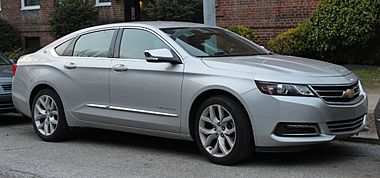 |
|
| Overview | |
| Production | 2013–2020 |
| Model years | 2014–2020 |
| Assembly |
|
| Designer | Steve McCabe (2006) |
| Body and chassis | |
| Body style | 4-door sedan |
| Layout | Front-engine, front-wheel drive |
| Platform | GM Epsilon II LWB |
| Related | Cadillac XTS Buick LaCrosse Saab 9–5 |
| Powertrain | |
| Engine | 2.4 L LUK Ecotec I4 eAssist 2.5 L LKW Ecotec I4 3.6 L LFX V6 |
| Transmission | 6-speed 6T70 automatic 6-speed 6T40 automatic (eAssist only) |
| Dimensions | |
| Wheelbase | 111.7 inches (2,840 mm) |
| Length | 201.3 inches (5,110 mm) |
| Width | 73 inches (1,900 mm) |
| Height | 58.9 in (1,496 mm) |
| Weight |
|
The tenth-generation Impala was introduced at the 2012 New York Auto Show for the 2014 model year, with sales and production commencing March 4, 2013. The tenth generation Impala was the first North American sedan in 20 years to earn Consumer Reports' top score, with a score of 95 of a possible 100 points.
This tenth generation Impala, according to autoblog.com, is once again classified as full-size, the previous generation having been mid-size. It is larger than the previous generation, sharing the extended Epsilon II FWD platform with the Cadillac XTS. It was assembled in Oshawa, Ontario, Canada, alongside the ninth-generation Impala (now renamed the fleet and rental exclusive-only Impala Limited), and at the Detroit/Hamtramck Assembly in the United States. All trim levels are equipped with a six-speed automatic transmission with sport and manual shifting modes.
The tenth generation models were shipped to dealerships across North America on March 25, 2013, and officially went on sale to the public April 1, 2013. That same day regular production on the Impala (the 2.4L eAssist and 3.6L equipped versions/LT2 and LTZ2 trims only) began at their Oshawa plant, while production at GM's Detroit-Hamtramck plant (the 2.5L equipped versions/LS, LT1 and LTZ1 trims) started production on April 8 and arrived to dealerships in May. The eAssist versions went on sale in the fourth quarter of 2013.
In 2014, the Impala saw its share of the full-size sedan market increase to 14.7 percent, up from 6.9 percent in 2013.
The 2014 Impala came standard with 18 inch wheels (19, and 20 inch offered in higher trims), low profile HID Headlights and LED daytime running lights (On LTZ trim) and offered three engines; a 2.5 L 4-Cylinder (the first time the Impala will use this type), a 2.4 L 4-Cylinder with hybrid-assist technology, and a 3.6 L V6. The interior came equipped with a 4.2-inch color display featuring Chevrolet MyLink (LT and LTZ trims), HD Radio (all trims) and Pandora Radio (LT and LTZ trims), Active noise cancellation for all 4-cylinder options, while new safety features included 10 Standard Airbags combined with OnStar. Optional features for the 2014 model included "full-speed-range adaptive cruise control, collision mitigation braking, forward collision alert, lane departure warning, side blind zone alert, rear cross traffic alert, rear camera and rear-park assist."
Model year changes
For 2015, 4G LTE was added to OnStar as an optional feature HD Radio was no longer offered starting with the 2015 model year. In addition, the eAssist version was discontinued due to low sales.
For the 2016 model year, the Impala went from five to four trim levels: LS, LT1, LT2, and LTZ2. A Midnight appearance package was added as an upgrade for the LT and LTZ level trims, which included unique black-pocket wheels and gloss black badges in addition to the standard black paint. Five new colors were introduced: Siren Red Tintcoat, Citron Green Metallic, Heather Gray Metallic, Mosaic Black Metallic, and Green Envy Metallic; six colors were dropped: Autumn Bronze, Red Rock, Crystal Red Tintcoat, Ashen Gray, Silver Topaz, and Champagne Silver. The Jet Black/Brownstone interior color scheme was dropped. 2016 models also came equipped with a new 800 cold-cranking amps battery, replacing the 900 CCA. Wireless charging for devices, front and rear splash guards, as well as lane change alert were added. The CD player was now only offered as standard equipment on the LTZ, but available as an option on other trims as part of the Technology package. 2016 also saw the addition of Apple CarPlay and Android Auto Capability features; only one phone brand at any one time can be used.
In addition to the "OnStar/Connections Plan" being rebranded as the "Guidance Plan", the 2016 Impala's option packages were rebranded:
- LS Convenience to Protection Package
- Advanced Safety to Driver Confidence Package
- Premium Seating to Leather Package
- Premium Audio and Sport Wheels to Technology Package
- Comfort and Convenience to Enhanced Convenience Package
- Premium Audio to Advanced Technology Package
The 2017 model year Impala only saw minor changes, with the top of the line LTZ trim rebrand as the Premier trim and Pepperdust Metallic introduced as a new color option. The LS trim, previously available only with the four-cylinder engine, became available with the V6 engine in addition to the four-cylinder engine.
The 2018 model year Impala went from four trims to three: LS, LT, and Premier. The LT level trim added Entertainment, Convenience, and Leather packages options, while the Premier trim received the top of the line Convenience package. Keyless starts, rear camera view, and MyLink became standard on all three levels trims, as the LS trim deletes the 4.2 inch display and AM/FM radio features. Daytime running lights became standard on LT and navigation became standard on Premier. During the Third Quarter of 2018 three new colors, Nightfall Gray Metallic, Cajun Red Tintcoat, and Graphite Metallic, were introduced.
The 2019 model year Impala only saw minor changes. The jet black interior was added to the LT convenience package, while the accessory level wheel locks became standard on all trims. The Graphite Metallic color was discontinued.
The 2020 model year Impala (its final year for the sedan) dropped the LS trim, leaving only the LT and Premier level trims. Only the 3.6L V6 engine was offered.
Engines
| Engine | Power | Torque | Economy (mi/galU.S.) City/Highway/Combined |
Tailpipe CO2 (grams per mile) | Notes |
|---|---|---|---|---|---|
| 2.4L LUK Ecotec I4 with eAssist | 182 hp (136 kW) @ 6700 rpm | 172 lb⋅ft (233 N⋅m) @ 4900 rpm | 24 / 35 / 28 | 312 | 197 hp (147 kW) combined |
| 2.5L LKW Ecotec I4 | 196–197 hp (146–147 kW) @ 6300 rpm | 186–191 lb⋅ft (252–259 N⋅m) @ 4400 rpm | 21 / 31 / 24 | 367 | |
| 3.6L High Feature LFX V6 flex-fuel | 305 hp (227 kW) @ 6800 rpm | 264 lb⋅ft (358 N⋅m) @ 5200 rpm | 19 / 28 / 22 | 401 (385 E85) |
2015 Bi-Fuel
The 2015 Chevrolet Impala Bi-Fuel runs on CNG (compressed natural gas) and gasoline. Unveiled in October 2013 by General Motors CEO Dan Akerson, the Bi-Fuel Impala would be offered to both fleet customers and retail. It is the only full-size CNG vehicle manufactured in North America. The new Impala will join the Honda Civic as a rare factory made CNG car to come straight from a major automaker and available for retail sales.
The 2015 Chevrolet Impala Bi-Fuel has a 500-mile driving range. It will allow the driver to switch from gasoline to CNG or from CNG to gasoline at the push of a button. The CNG tank is placed in the trunk. The Impala Bi-Fuel was one of the five finalists for the 2015 Green Car of the Year Award during the 2014 Los Angeles Auto Show, but lost to the BMW i3.
International markets
The Impala went on sale in South Korea as an export vehicle for the 2016 model year, marking the first time that Chevrolet had offered an American-built full-size sedan in the Korean market.
Trim levels
The tenth-generation Chevrolet Impala is available in three trim levels: LS, LT, and LTZ (later Premier). Each trim level includes a generous amount of standard equipment:
LS Includes: 2.5L EcoTec Inline Four-Cylinder (I4) gasoline engine, six-speed automatic transmission, Eighteen-inch (18") black-painted steel wheels with full plastic wheel covers, 4.2-inch (4.2") color LCD radio with Bluetooth (2014-2017 models), eight-inch (8.0") Chevrolet MyLink infotainment system (2018-2019 models), 100-watt six-speaker audio system, keyless entry, premium cloth seating surfaces (2014-2017 models), premium cloth seating surfaces with leatherette trim (2018-2019 models), power-adjustable front driver's bucket seat, OnStar with 4G LTE Wi Fi capabilities (2015-2019 models), leather-wrapped steering wheel, split-folding rear bench seat, color-keyed exterior door handles, and black side mirrors. The LS trim was discontinued after the 2019 model year.
LT Adds to LS: Eighteen-inch (18") aluminum-alloy wheels, eight-inch (8.0") Chevrolet MyLink infotainment system, security system, remote vehicle start, premium cloth seating surfaces with leatherette trim, dual power-adjustable front bucket seats, color-keyed side mirrors, and wood interior trim.
LTZ (Premier) Adds To LT: 3.6L VVT V6 gasoline engine with FlexFuel capabilities, nineteen-inch (19") aluminum-alloy wheels, keyless access with push-button start, luxury leather-trimmed seating surfaces, dual heated front and rear seats, heated leather-wrapped steering wheel, exterior LED Daytime Running Lamps (DRL's), rearview backup camera system, chrome-accented color-keyed exterior door handles with touch sensors, and chrome side mirrors.
Discontinuation
There was speculation that GM would discontinue the Impala in 2018 due to declining sales of American full-size sedans, in order to make room for more production of crossover SUVs. However, GM CEO Mary Barra later said that unlike Ford and FCA, GM had no plans to exit the sedan market, and at the time stated that the Impala would continue in production as a way to fill the void left by the planned departure of the Ford Taurus in 2019.
GM later reversed course and made plans to idle the Detroit-Hamtramck and Oshawa assembly facilities and retire the Impala nameplate. After originally intending to end production in June 2019, GM decided to keep the Impala in production, with the extension of the assembly plants' idling to 2020. The final Chevrolet Impala was built at the Detroit/Hamtramck assembly plant on February 27, 2020.
Yearly sales
| Calendar year | United States |
|---|---|
| 2000 | 174,358 |
| 2001 | 208,395 |
| 2002 | 198,918 |
| 2003 | 267,882 |
| 2004 | 290,259 |
| 2005 | 246,481 |
| 2006 | 289,868 |
| 2007 | 311,128 |
| 2008 | 265,840 |
| 2009 | 165,565 |
| 2010 | 172,078 |
| 2011 | 171,434 |
| 2012 | 169,351 |
| 2013 | 156,797 |
| 2014 | 140,280 |
| 2015 | 116,825 |
| 2016 | 97,006 |
| 2017 | 75,877 |
| 2018 | 56,556 |
| 2019 | 44,978 |
| 2020 | 9,942 |
Safety
In the Insurance Institute for Highway Safety's crash tests, the 2000 to 2005 Impala was given a "Good" rating overall for good structural performance and no chance of any significant injury in a crash of its severity, except for maybe a minor lower-left-leg injury, such as a bruise or sprain. The 2006 to present Impala is given a lesser overall "Acceptable" score for front impact collisions. and a "Good" score for side impacts. Side-curtain airbags are standard for front and rear rows; side torso airbags previously unavailable became standard on all trim levels beginning with the 2009 model year. GM made some minor structural enhancements to the Impala, beginning in December 2009; models produced after that received a "Good" in the IIHS frontal offset crash test.
In September 2009, a local news station's investigative team in Rhode Island discovered that GM's fleet customers who purchased the 2006–2009 Impala were able to order them with the side-curtain airbags deleted for a savings of $175 per vehicle. Because these fleets typically sell off their cars after two to three years of use, many of the Impalas that were built without side-curtain airbags became privately owned cars.
Another potential safety hazard, affecting Impalas of model years 2007 and 2008, is premature rear tire wear caused by defective rear suspension components. Police vehicles were upgraded to correct this defect and law enforcement agencies were compensated for expenses incurred for tire replacement, but civilian vehicles were not recalled. As a result, Impala owners launched a class action lawsuit in July 2011 against General Motors. In response, the current General Motors leadership claimed about a month later that they are not responsible to repair the defective vehicles manufactured pre-General Motors Bailout. Subsequently, in late September, a new lawsuit, disputing the GM response, was initiated by three of the estimated 400,000 Impala owners. (GM is also facing a similar legal dispute regarding a pre-bankruptcy upgrade to its OnStar system which left thousands of users without service in violation of their paid-up contracts.)
On April 22, 2014, the NHTSA opened an investigation into 60,000 2014 Chevrolet Impala models over concerns relating to the sedan's emergency braking system. This followed the NHTSA receiving a complaint from a driver who experienced "inappropriate activation of the emergency braking system," adding it "alleges that the driver assist system inappropriately activated emergency braking bringing the vehicle to a complete stop under what the driver considered to be full braking force." The driver also went on to say that he heard three to four beeps from the system while driving the rented vehicle, which had only 2500 miles on it. GM is fully co-operating in the investigation.
Awards
Motor Trend magazine awarded the full-size Chevrolet including the Impala as its 1977 Car of the Year.
Automotive Fleet and Business Fleet magazines awarded the Impala the 2006, 2007, and 2008 Fleet Car of the Year.
Canadian Automobile Association (CAA) selected the Impala for its 2006 Pyramid Award for Environmental Initiatives for the launch of its new ethanol-powered E-85 model.
NASCAR
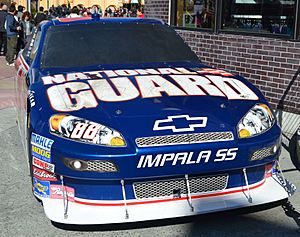
In 2007, the Impala began to replace the Monte Carlo on the NASCAR stock car racing circuit; more specifically, on all the scheduled racing events where NASCAR has mandated the use of a car with different (and some new) specifications, better known as the Car of Tomorrow.
The Impala was also used to represent Chevrolet in the Nationwide Series. In 2013, the Impala was replaced by the Camaro in the Nationwide Series.
The Impala was also used in the NASCAR Pinty's Series. It was replaced by the Camaro in 2018.
The 2012 NASCAR season marked the end of use of the Impala nameplate on stock cars. From 2013 to 2017, Chevrolet drivers began driving the Holden VF Commodore SSV based Chevrolet SS in Sprint Cup until the Chevrolet SS was discontinued after 2017.
Images for kids
See also
 In Spanish: Chevrolet Impala para niños
In Spanish: Chevrolet Impala para niños



